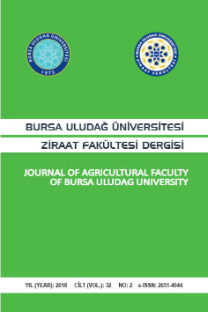İzmit Körfez suyunun kirlilik parametreleri üzerinde fabrika atık sularının rolü
Bu çalışma büyük sanayii kuruluşları kirlilik parametrelerinin İzmit Körfezine getirdiği atık yükleri incelemek amacıyla yapıldı. Endüstri kuruluşlarından körfeze günde yaklaşık 59349.7 m3 su ile birlikte 1607.59 kg/gün BOİ5, 6881.18 kg/gün AKM, 463.553 kg/gün yağ ve gres, 14.192 kg/gün toplam ağır metal, 17.50 mg/1 N girmekte olduğu saptandı. Körfez deniz suyu analiz sonuçlarına göre endüstri kuruluşlarında TN 12.647 mg/1, TP 7.646 mg/1 olup kirliliğin açıklara doğru azalmakta olduğu belirlendi. Nitekim açıktan alınan numunelerde TN 6.01 mg/l, TP ise 1.695 mg/1 olarak saptandı. Kimya sanayiine ait A; (gübre üretimi), A3 (boya üretimi), Gıda sanayiine ait B; (sıvı yağ rafınasyonu), B2 (maya üretimi), B3 (süt ve süt ürünleri), Bs (sitrik asit üretimi), Metal sanayiine ait C3 (metal hazırlama-iletken plaka imalatı), C4 (boru endüstrisi), Selüloz-Kağıt-Karton sanayiine ait E2 (yüzey kaplamalı dolgulu kağıt), Tekstil sanayiine ait Fi (açık elyaf, iplik üretimi ve terbiyesi), F2 (dokunmuş kumaş terbiyesi), Deri-Deri Mamulleri sanayiine ait G (aglomera deri ve pres kaplama) atık suların kirlilik parametrelerinin "Su Kirliliği Kontrol Yönetmeliği" deşarj standartlarına uygun olmadığı belirlendi. Endüstriyel kaynaklı yüklerin gelecekte artmaması için birincil ve ikincil arıtımın azot ve fosfor açısından yeterli olmasının yanı sıra, yeni kurulacak tesislerde üçüncül arıtımın uygulanmasının gerekli olduğu sonucuna varılmıştır.
Anahtar Kelimeler:
fabrika sıvı atığı, atık su arıtımı, gıda sanayi, ağır metaller, kirlilik, atık su, sitrik asit, Türkiye, biyokimyasal oksijen ihtiyacı, ticari gübreler, tabakhane atıkları
The role industrial waste eater on the pollution parameters in İzmit Bay
This study has been carried out to investigate the effects of heavy industry . on the pollution parameters in İzmit Bay. It has been found that 1607.59 kg/day BODS, 6881.18 .kg/day Total Suspended Matter, 463.553 kg/day oil and grease, 14.192 kg/day total heavy metal and 17.50 mg/1 N are discharged into the sea with approximately 59349.7 m3 waste water. According to the results of the bay water analysis in the vicinity of discharge point TN is 12.647 mg/1 and TP is 7.646 mg/l while the amount of pollution is decreased in the samples that were taken from the deep sea areas. The amount ofTN in the latter samples is TN 6.01 mg/1 and TP 1.695 mg/l. It has been determinated that pollution parameters of waste water from Chemistry Industry A1 (fertilizer production), A3 (point production), from food industry B\ (liquid oil refinery), B2 (yeast production), B3 (milk and milk products), B5 (citric acid production), from metal industry C3 (metal preparation, conductor plaque production), C4 (pipe industry), from Paper and Cardboard Industry E2 (surface plate paper), from Textile Industry Fj (Lif threat production and treatment), F2 (weaved fabric treatment), from'Leather and Leather Products G (aglomera leather and press cover) do not follow the discharge standarts of "Water Pollution Control Regulations". It has also been concluded that in order not to increase the accumulation of industrial waste, it is necessary to have a third filtering phase as well as having sufficient first and second filter of Nitrogen and Phosphate.
Keywords:
factory effluents, waste water treatment, food industry, heavy metals, pollution, waste water, citric acid, Turkey, biochemical oxygen demand, fertilizers, tannery waste,
- ISSN: 1301-3173
- Yayın Aralığı: Yılda 2 Sayı
- Başlangıç: 1981
- Yayıncı: Ahmet Akkoç
Sayıdaki Diğer Makaleler
HÜSEYİN YILDIZ, BAHRİ YILDIZ, Gülsüm EREN
Tüketime sunulan kıymaların yağ oranlarına göre sınıflandırılması
G.Ece SOYUTEMİZ, Şahsene ANAR, Kader ÇETİN
Alyuvar potasyum (EK) tipleri ve bazı ekonomik özellikler arasındaki ilişki
Köpek ve kedilerde kalıtsal göz hastalıkları ve ırk predispozissyonları
Yem analizlerinde infrared spektroskopinin kullanımı
HATİCE ERDOST, Mine Yakışık, Serdar KARDEŞ
Hakan BİRİCİK, İ.İsmet TÜRKMEN
Tavuk ve ördek bacak kaslarının fonksiyon yönünden karşılaştırmalı olarak incelenmesi
